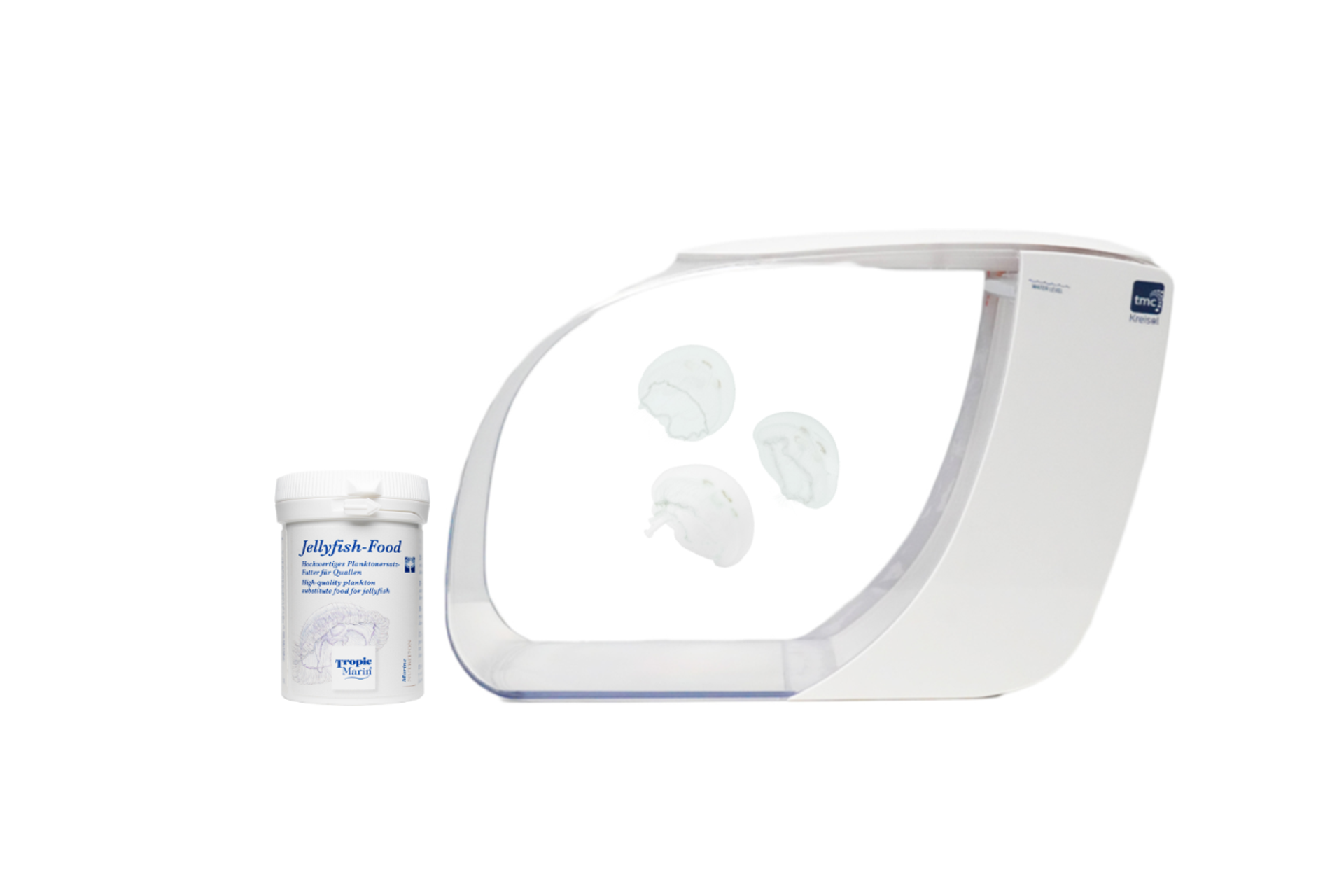Feeding Your Jellies

In the last year or so, we've started carrying two different sizes of Kreisel Aquarium from TMC (Tropical Marine Centre), which have proven to be very popular and with good reason! For those of you who are new to the term, a kreisel aquarium is a circular aquarium that is the best way to display Jellyfish, and more recently they've also been used to rearing fish that have extended larval periods (a whole other article). Some of the world’s most magical aquatic displays feature Jellies in Kreisel displays like the magnificent tanks at the Monterey Bay Aquarium.
It was long thought impossible to keep Jellyfish in captivity because they would always get sucked into the filtration systems and even if they didn't their food would be. Jellyfish require very clean water and don't deal well with bubbles and thus require strong filtration that only adds gentle flow. The Kreisel tank fixed all that by incorporating a circular flow pattern (called a gyre), in a circular tank, where the intake for the filters was outside of the circular flow pattern, which keeps the Jellyfish and their food in the center of the tank. It is brilliant in its effectiveness and its simplicity. TMC broke new ground by making this technology easily accessible to everyone with their affordable and easy, fully self-contained kreisel systems.
We have a much more in-depth article on the site that talks about the history of this system, and how to set up these tanks elsewhere on the website. https://www.qualitymarine.com/news/keeping-up-with-the-kreisels/ The immediate popularity of these systems has sparked a bunch of questions from our socials about feeding Jellies and there are a bunch of options for you to use. Like any of the aquatic critters we care for and provide for our partner stores, we recommend a varied diet for them. Things like Gamma Rotifers, Cyclops and even the smaller Copepods are great foods. Live foods like Baby Brine Shrimp (Artemia) are excellent choices as well, but you'll also need base food. Something you can feed easily, that is quality, well rounded food. To conclude, we suggest you utilize the Tropic Marin Jellyfish Food.
Feeding jellyfish is easy, as they don't have a feeding trigger like fish. They just collect food passively with their stinging cells and tentacles. If food is available, and the Jelly needs food, the Jelly consumes the food. This means that the food doesn't have to act a certain way to get the Jellyfish to eat. If an acceptable morsel comes in contact with their stinging cells, they consume it.
Tropic Marin's Jellyfish Food is a nutritionally complete food, that is shelf stable so there isn't a need to refrigerate or freeze it. (Though it can be frozen or refrigerated.) Just keep it in a cool place, out of direct sunlight. This food has been formulated from the highest quality raw ingredients like shrimp meal, algae, fish meal, yeast, fish oil, spirulina and a few different vegetable proteins to be rich in energy, B12, trace elements, vitamins and carotenoids; all essential elements for the health and growth of your Jellies. It is a finely powdered mix making it easy to consume for even small Jellyfish. It's also a great food for the filter feeders in your other tanks like feather dusters etc!
One of the worst things a hobbyist can do to a Jellyfish display is overfeeding. Overfeeding will cause nutrient buildups which is bad for the Jellyfish, and it also acts as fuel for algae in the system, which is to be avoided. It is difficult to remove the uneaten morsels from Kreisel tanks when the Jellyfish are “full” as those bits are still floating around in the current. Feed them once a day and feed them only enough so that all the food is consumed within 10-15 minutes. One measuring spoon (included) is enough food for a single feeding for two small to medium Jellyfish. Use this ratio when mixing up your food. Stir as much food as the ratio dictates into a small cup of saltwater and wait a few minutes for that food to be nice and hydrated. Then gently add that food to the center of the gyre with a pipette. Do not target feed / directly push the food at the Jelly with the pipette, or you risk damaging them. If the Jellyfish consume it all before your fifteen(ish) minutes are up, add a little more food tomorrow. If they can't consume it all in that same time frame, then feed a bit less tomorrow. If you've fed so much that some settles out, try to remove it with the pipette.
Desktop Kreisels are some of the coolest tanks you can have and now that you have one, you need to feed your Jellies right! By all means, change up that food on occasion as variety isn't just the spice of life, it's a requisite for good health; heck sometimes you can even send some live baby brine their way. That being said, you won't do better for a daily feeder than Tropic Marin's Jellyfish Food. We use it here at Quality Marine and recommend you use it in your Jelly displays too!